I hope you enjoy reading this blog post.
If you want to get more traffic, Contact Us

Click Here - Free 30-Minute Strategy Session
Be quick! FREE spots are almost gone for this Month. Free Quote

Of all the categories of websites out in the world wide web, none can be more challenging to optimize for search engines than ecommerce sites. Therefore, ecommerce SEO requires a rigorous approach that encompasses all aspects of SEO techniques.
While this may sound as a daunting task, this article aims to breakdown the entire process into bits of highly actionable and objectively measurable steps so you can make the most of your ecommerce site.

Click Here – Free 30-Minute Strategy Session
Be quick! FREE spots are almost gone for this Month
So let’s begin without further ado!
The execution of any business project begins with planning and research.
And SEO for e-commerce websites is no different.
Whether you already have an e-commerce website or planning to start one, you probably know that targeting the right keywords is the key.
Going one step further, it must also be noted that by targeting the wrong keywords, you are harming your site as the these keywords will lead to a high bounce rates and lower conversion rates.
Both of which are red flags for search engines.
Another important area of research that an equal role, if not more, is competitor research.
It not only lets you know what’s working for them, in other words what your potential customers are looking for, but also what’s not working for them.
With this information, you are well on your way to achieving great ecommerce SEO.
So let’s look into each of these research components in detail.
Keyword research can in turn be broken down to three critical areas.
When it comes to ecommerce SEO and keywords, the most important factor one must consider is the relevancy.
Other two factors you must keep in mind are search volume and ranking difficulty.
A great place to start is Google’s AdWords Keyword Tool.
Using the Keyword tool, come up with a list of keywords that are highly relevant to your brand and products, and have high search volumes.
Depending on your market positioning, the search volume could be either local or global. It’s a good idea to start from local search and then gradually move towards global search volumes.

Now, head over to Moz’s keyword tool to determine the difficulty level of each keyword that you came up with in the previous step.
Bingo! You now have a list of keywords that are relevant with reasonably high search volumes, and relatively easier to rank.
An important aspect to keep in mind is choose specific keywords and stay away from generic keywords.
The problem with generic keywords is that they are too tempting given the high search volumes.
However, these keywords are a double-edged sword. Most of the times, users who use generic keywords don’t find what they are exactly looking for.
For example, if you are in the business of selling premium coffee filters, and use highly generic keyword such as ‘coffee’, your visitors can range from those looking for coffee powder to those looking for coffee cups.
Every time such visitors move away from your site, for obvious reasons, they hurt your website’s credibility in the eyes of search engines.
One of the greatest challenges of ecommerce SEO is that the product pages have lower scope for content compared to other pages.
As result, it becomes highly difficult to target several keywords within these pages.
So how to get your website to rank for such keywords that are difficult to include on product pages?
The simple answer is ‘Blogs’.
Creating blog content for your website is an effective way to include any keyword you want as you are at liberty to choose the blog topic so you can accommodate these keywords.
One set of keywords that’s almost impossible to include within your product pages is the set of long-tail keywords.

So what are long-tail keywords?
Long-tail keywords are basically long phrases that users type in to search engines. These keywords are used to enter highly specific search queries.
Sticking to the coffee filter example, a typical long-tail keyword would be ‘premium coffee filters that are ideal for quick coffee brewing’.
You might argue that this phrase can be easily adapted as a part of the benefits.
However, you must keep in mind that each long-tail keyword by itself will have a very low search volume and the eventual high search volume you will get from these keywords is a result of cumulative volumes of many such key phrases.
Simply put, you will have dozens of such phrases that you need to include in your site and together, they form one block of your search volume.
Now, writing a piece of content for blog pages should always be focused on creating great content that’s useful and relevant for your readers.
Search engines are getting smarter with each update and with semantics as the basis for their algorithm, they can easily differentiate between content that’s written for search engines from content that’s written for users.
Avoid stuffing you blogs with too many keywords and create content in such a way that your keywords fit in naturally.
So what is keyword cannibalization?
Keyword cannibalization is a situation where more than one page of your website are targeting the same keyword.
In other words, two or more pages within your site is competing with each other to rank higher.
With Keyword Cannibalization, you become your own competitor! And you simply cannot afford to be in such a situation.
If you have a keyword that’s already in use on a products, or any other, page on your site, you should not use the same keyword for writing a blog.
The same applies to other pages within your site and not just blogs.
How to avoid such a situation when your are handling hundreds of pages on a ecommerce site?
The magic tool is ‘Spreadsheets’.
Simply list all the keywords against each of the pages on a spreadsheet. When you sort the ‘keyword’ column, there should not be any duplication. Simple as that.
If you consider all the three factors we have discussed so far, you are doing well as far as keyword research is concerned.
Just like Keyword Research, Competitor Research can be categorized into four distinct areas. They are:
This step allows you to determine which keywords your competitors are using and whether or not to target the same keywords through ‘Domain Authority’ and ‘Page Authority’ of the web page in question.
Both these steps, finding the keywords, and DA and PA of page, can be easily achieved through the free MOZ tool bar.
Once you install and open the tool bar, simply copy paste the URL of the page you are analyzing.
By default, you will land on the ‘Page Elements’ tab. Here you will find meta title, meta description and keywords.
Most websites include their targeted keywords in this section. However, you don’t find keywords here, the title and description will contain their most targeted keyword/keywords.
You could also use ‘Get a full on-page keyword analysis’ option from the same section.

To find the domain authority and page authority, click on the tab, ‘Link Data’. Note that the ‘Domain Authority’ is a measure of the overall site authority and therefore it will be a single value for the entire site under ‘Root Domain’.
So what’s the significance of PA and DA?
PA and DA values gives a relative position of your competitors’ sites in terms of their credibility and popularity in the eyes of the search engines.
If these values are significantly higher than PA and DA values of your site, there’s no point in targeting the same keywords as it can be really difficult to rank better than them.
Even if you decide to take on the challenge, it might be highly time consuming and a drain on your resources.
With a bit of effective keyword research, you can always come up with a host of other keywords that are relatively easier to rank for, and offer good ROI.
One cannot simply ignore the source of your competitors’ back links when trying understand what exactly are your competitors up to.
To get a list of back links that link to your competitors’ site, you could use a tool such as the Open Site Explorer.

Simply enter the root domain of a web site and you can instantly look at all the sites that have outbound links to your competitor’s site.
There are various time-tested techniques to come up with an effective strategy to get back links from the same sites to your site.
Some of them are blogger outreach, press outreach, and setting up your company’s page on these sites. More on this in the later sections.
Couple of things to keep in mind:
Also, by getting back links from quality sites that also link back to your competitors’ sites, you are only being on par with them.
If you want to go one up on them, you should target other quality sites for back links.
A web site’s structure should make it easier for the visitors to effortlessly navigate within the site and reach desired sections of the site with ease.
Search engines place high emphasis on the overall site structure so their users have a good experience with the sites that engines recommend.
So if you want to rank high on search engines, this is one crucial factor that you need to focus on.
And just like other important ranking factors, coming up with a clean structure begins with an in-depth analysis of your competitors’ sites.
From an ecommerce SEO stand point, you should pay particular attention to the following aspects:
Once you have carefully analyzed your competitor’s site for the structure, you can decide on one of the following:
If you decide to adapt some of the strategies that a big brand uses, you must be aware of all the pit falls.
For example, pages that are located very deeply within the architecture might not receive much visibility when compared to those that are higher up the order.
You might find that a big ecommerce site has a site structure that’s counter intuitive to the principles of a good structure that’s easy to navigate.
Under such circumstances, you should exercise caution and refrain from committing the same mistake.
Once you have completed a thorough analysis of your competitors site and have a fair idea of what they are up to, the options you have are similar to the ones we discussed in the previous section.
Find out the factors that are doing wonders for your competitors and adapt them.
Find out factors that are working but needs slight modifications.
These two tactics will put you on par with your competitors. However, to really perform better than them, you must differentiate your web site so you can get the best of both worlds. Ask yourself as many questions as possible.
Can you add a blog to your site because your competitor doesn’t have one?
How will you position the most popular products? Will they be clubbed under ‘Popular Products’ or will they be showcased within their category?
Will you have social plugins for your visitors to share a product they like?
How will you use re-marketing options for repeat visitors?
Come up with an extensive list of changes that will give your web site a clear advantage over your competitors.
No amount of keyword and competitor research will help you if your site has inherent errors.
It’s imperative that your site is technically sound and free of all coding bugs for an optimal performance.
Luckily, these factors are highly objective and nature and therefore relatively simpler to diagnose and fix.
Two of the most important factors you must consider while performing a site audit are:
Among all the free tools that are available out there, Screaming Frog is by far the best.
This tool will crawl your site just like the search engines and can provide you with a detailed report of all the errors that search engines mark as red flags.
From broken links and low-quality images to CSS errors and missing header tags, you will be able to exactly determine all the faults.
Some of the top errors that you should focus on include:
Once you have completed the audit and taken the steps to correct them, run the site through the tool again to ensure that your site is 100% error free.
So you have created an awesome ecommerce site that’s perfectly optimized for all the right keywords, and is flawless from a technical stand point.
However, your visitors are abandoning your site because it takes too long to load.
Let’s face it.
Nobody likes to wait while a site is loading and that includes you!
According to some studies, 40% of the users will abandon a site that takes more than 3 seconds to load.
Do you want to lose hard-earned visitors just because your site is slow?

Again, there are powerful tools that can accurately determine the time your site takes to load and Pingdom is one of the best.

In the example above you can see that Mashable loads in under 2 seconds and that’s pretty impressive.
As an ecommerce site, aim for a loading speed of around 3 seconds and if your site takes more than that, you might want to consider some of these options:
The above steps are some of the basic reasons why a site might load slowly. You might need to determine specific problems that are peculiar to your site to be 100% sure.
While off-page page optimization can significantly contribute more towards your ecommerce SEO values than on-page optimization, it’s still no reason to ignore your on-page SEO endeavors.
In fact, if you believe that your site should be user friendly and that your visitors should have a hassle-free experience while browsing your site, you must follow all the on-page SEO techniques to the letter T.
With a total contribution of anywhere between 30-40% of your SEO values, you should leave no stone unturned and ensure that all the factors that encompass on-page SEO are taken care of.
The 8 most important on-page SEO factors you should consider are:
Let’s look at each of these factors in detail.
Selecting the right keyword through keyword research is only half the job done. Implementing a keyword within a page or a blog is as much important.
As I mentioned at the beginning of this article, each of your page must have a unique keyword (or a set of keywords) without any of them being repeated on another page.
Another point worth mentioning is the importance of placement of keywords. Your body copy contains various elements and you should ensure that your primary keyword appears in all these elements. They include:
Two of the factors from the list that needs special attention are URLs and Meta data – titles and descriptions.
Just because these elements should include keywords, it doesn’t mean that they contain keywords in some random manner.
They should still be user friendly and add certain value to your readers.
As a best practice, URLs must have keywords as extensions.
If the keyword is a phrase and consists of more than one word, each word should be separated by a hyphen without any space.
Meta titles and descriptions should give your readers a gist of what they can find on the page. Think of these lines as an ad copy.
They must entice your readers to click through and visit your page.
Not only does user friendly meta tags result in higher click through rates, they also send signals to search engines about higher traffic.
The engines then perceive your site to be popular and places your site more often in the search results. You see the positive upward spiral here right?
Let’s consider a good and a not-so-good examples of meta tags.

Which one would you rather click on? The one that’s stuffed with keywords to game the search result or the one that adds value to the reader through a benefit?
Obviously, you would click on the latter. Once you take this approach and make keyword placement as user friendly as possible, on-page SEO becomes that much clearer and easier.
Whether you are revamping your existing site or coming up with a new one, site architecture and structure must be at the forefront of your endeavors as an owner of an ecommerce site.
Setting up an ecommerce site, with its sheer size, can be a daunting challenge because of hundreds of pages each displaying a different product.
Add to this the provision to add new pages and scale up as new products arrive, and you can clearly imagine the task on your hands.
If you have a strong site architecture that’s designed keeping in mind the ease of navigation, it should not be as difficult as it seems.
With tools such as LucidChart, you can easily create a visual information structure that can be then used to come up with an effective site plan.
One of the most popular terms among SEOs these days is ‘flat architecture’.
This involves building a web site in such a manner that your users can land on products page from home page with minimal number of clicks.
This also ensures that maximum ecommerce SEO values, or ‘link juice’ as it is more popularly known as, can be passed from your home page to those in the lower order through internal links.
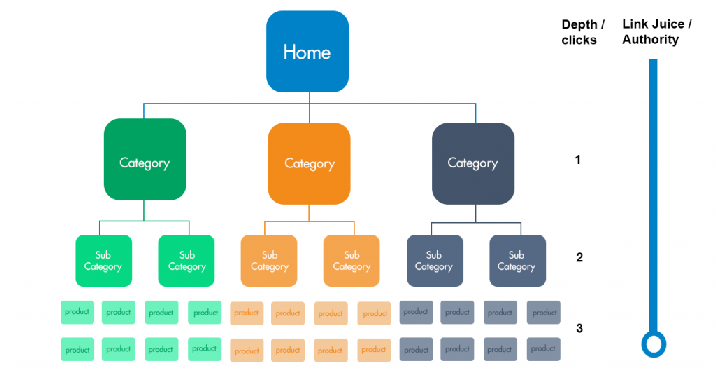
Keywords play an important role in creating a logical flow from the top of the site structure, the home page, to the bottom sections, categories, sub-categories, and products.
When selected properly, keywords can be clearly designated as to which part of the site structure each belongs, and search engines and users will find it easier to navigate.
Take a look an example of a good site structure.
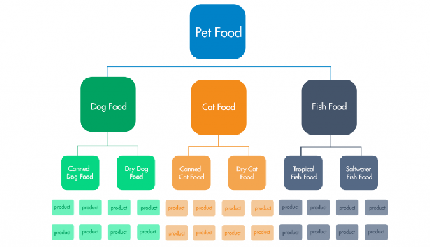
This is a simple example and your site could be far more complex. But fret over it much. There are numerous forums, bloggers, and a very supportive SEO community that’s easily approachable.
In simple terms, internal linking is linking a page of a site with another page of the same site.
Internal linking adds ecommerce SEO value to your site in many ways. The most important being helping your visitors navigate your site effortlessly.
Another aspect of internal linking that boosts your SEO value is the ability to create anchor texts. This in turn contributes to the ranking of your top keywords.
Here’s a graphical representation of a typical internal linking within a site.

For an ecommerce site, you have to keep in mind that you cannot link internal pages randomly or pack your web site with links.
The pages you link must have something in common and the link should naturally fit in to your text content.
If you have too many internal links, search engines will interpret this as manipulation and your site could be penalized.
Another point worth noting is that it can be tempting to use few top keywords as anchor text.
Search engines look for variety in anchor texts and repeated keywords can be a red flag.
Play around with your anchor texts and keywords to come with internal linking that’s natural and relevant.
Always ask yourself “Is this link helping my visitors navigate better? Is it relevant to what they are looking for?”
Once you have completed internal linking, you can then create a sitemap using any one of the various tools online and submit it to the search engines.
This enables the engines to crawl and index your pages.
One term you will come across a lot while trying to learn more about SEO is ‘UX’.
It simply stands for ‘User Experience’. Whether it’s an app or a web site, brands and businesses spend a considerable amount of their resources to make sure that their users have a nice experience.
As an ecommerce site, it is of paramount importance to you that you incorporate user-experience principles right at the design phase of building your site.
Your users must find your site easy to navigate, helpful in finding what they are looking for, and most importantly, fun to use.
Remember, most of your visitors are shopping online and shopping is such a fun experience. Make sure your visitors are not missing out on that fun part.
Another aspect of great user experience from an ecommerce site perspective is the check-out process.
From the design of the shopping cart to the payment gateway, ensure that each step is easy and quick.
Nobody likes to be stuck in during the check out process.
Using a live chat widget is a great idea to make sure that you are there with them each step of the way.
Whether they want to know more about a certain product or they want to be sure that their payment has through, your visitors will certainly appreciate your help.
A website that provides excellent user experience is bound to attract repeat customers. Which is great for your business and your site’s SEO.
It’s a very well known fact that mobile users have far out numbered desktop users when it comes to accessing the world wide web.
Internet companies such as Facebook and Google regularly publish data about their user base that clearly shows that mobile users dominate desktop users in terms of numbers.
So what does this mean for a ecommerce site? Well, the scenario is pretty much the same.
More and more users are taking to their mobile device to make purchases on ecommerce sites too! Here are some numbers to get you hooked.

Having a mobile version of ecommerce sites can be particularly challenging.
These sites have hundreds of pages and it can drain the resources of a company to create different versions with unique content on each version.
However, with the development of responsive design, you can have a single version of your site that works on any device.
What’s more, you don’t need to hire a full-time web developer to get a responsive design for your site.
The web is full of template stores, each with thousands of templates created just for ecommerce sites.
You can simply purchase one from such a store and customize it based on your requirements.
The customization is fairly simple and often involves just ‘drag and drop’ functions. The stores also offer full support at no extra cost.
Themeforest is one such store where designers and developers sell their templates at very attractive prices.
No category of websites can benefit from customer reviews like ecommerce websites.
Internet Retailer, a research firm specializing in e-commerce sites, pegs the increase in conversion rate between 14-76% when you add a product review section.
Another research firm, Jupiter Research, found that 77% of visitors to e-commerce sites read customer reviews before deciding to purchase.
In addition to positive reviews boosting your conversion rate, customer reviews also generate great content for your site.
Every customer is unique and therefore every review is fresh. Every time a review is written, search engines think that content is added frequently.
Fresh content that’s added frequently to your site.
What more can you expect for your site’s SEO?
There are various techniques that you can deploy to encourage your customers to leave a review.
Some review plug-ins such as WooTheme provides ‘Review for Discount’ option.
You could also send out an email a few days after your customer has received your product.
You could offer further support or answer to any questions they might have. And the same mail request for a review.
It’s totally up to your imagination how to get your customers to write a review.
But remember, being genuine always helps. If your product is really good and your customers had a great experience purchasing it through your site, they will always write a review.
Have you noticed that Google search results page looks a bit different? It’s not just text anymore. You will find images, YouTube thumbnails, customer reviews and ratings, and much more.


There are called ‘rich snippets’ and they have a huge impact on how your site ranks.
When a site includes rich snippets that search engines can display in results, users get greater idea about what they are likely to find. And search engines love it.
These are pieces of your site’s HTML code that highlight the parts of your page that users find most interesting.
It’s only obvious to point out that users are more likely to click on links that have these snippets than those that have plain text.
You can learn everything you need to know about creating rich snippets for your site here.
Having social media integrated into your e-commerce site is similar to having a customer review section. Only, the content gets distributed on the social network. That’s so much cool!
It lets your customers share their user experience and product reviews with their friends and family. Just the kind of promotion your products need.
Also, search engines take a cue from these social signals which in turn adds SEO value to your site.
Although social platforms such as Twitter and Facebook can add limited amount of SEO value, you should target Google+.

So you have incorporated all the elements that we have discussed so far and your website has been live for a while. What next?
The next logical step is find out if your strategy is working the way it’s meant to.
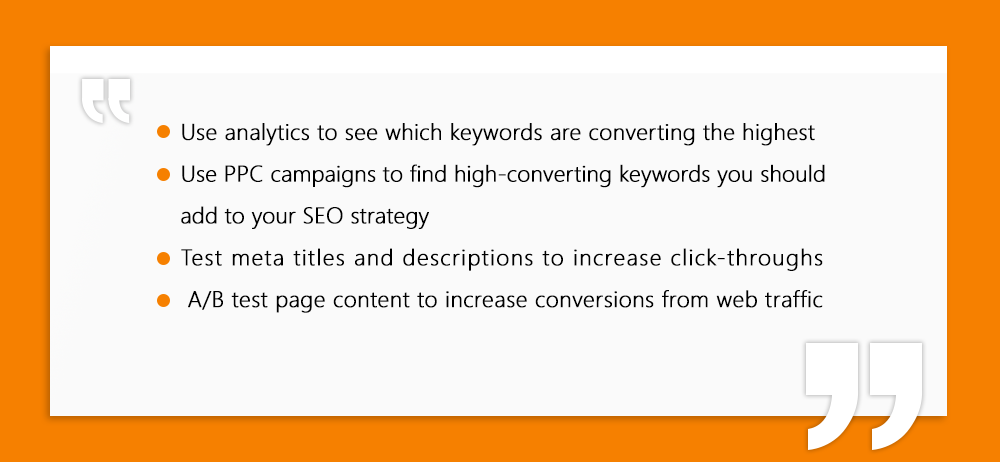
Some of the fundamental tests that you need to run on an on-going basis are:
These tests, when conducted frequently, helps you to improve your site continuously and stagnate.
This also ensures that you are constantly ahead of your competitors without resting on your past success.
Just to reiterate a point that we discussed earlier in the article.
You might come up with a long list of right keywords that you want to rank for – both specific and long-tail keywords.
However, you can only target one keyword in a page. So what happens to the rest of the keywords?
That’s where blogs come into picture. You can come up with a post for each keyword that were not used on the main pages.
What’s more, by adding a blog section to your site, you are able to frequently add fresh content to your website and that’s a huge boost for your site’s SEO.
The rules of creating content for your blogs remain the same. Create content that your readers will find useful.
It must be relevant to your visitors’ search queries, and directly related to your brand and industry.
Another great idea is to come up with ebooks and infographics that your visitors can download.
You could put together few of the blogs that have a common theme under one file and have your readers coming back for more!
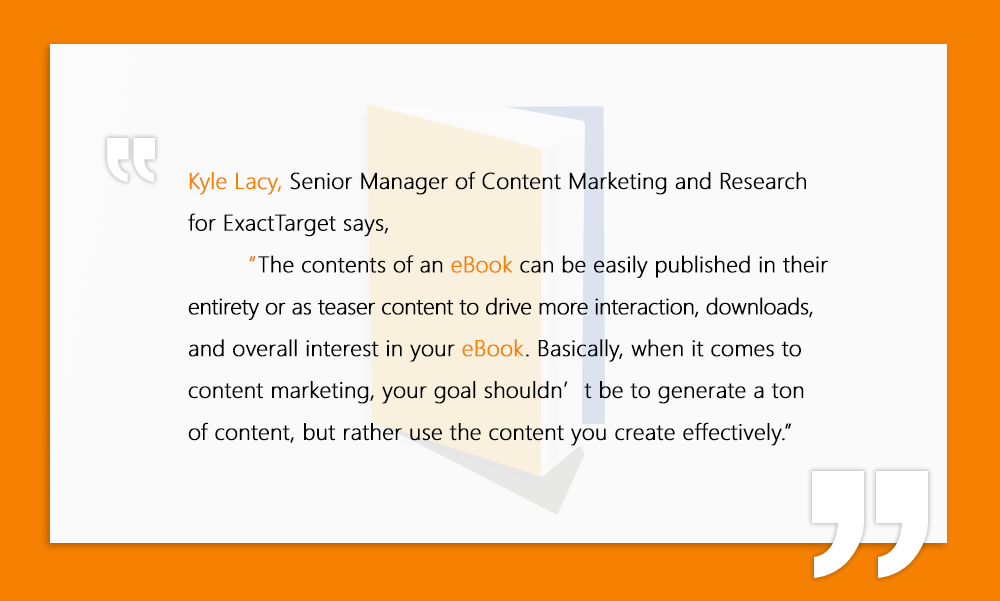
Think of all the ways that your product can add value to your customers’ life. Maybe how they can make the most of your product.
Get creative and come up scenarios that involve both your customer and your product.
For example, if you are in the business of selling outdoor adventure gear, you could come up with an article titled “Top 10 Trekking and Camping Trails” or “7 Things You Should Not Forget to Pack Before Venturing Out”.
Once your blogs are popular and have a considerable number of readers, your can set up a lead generation form for your readers to share their email address before they can download your ebooks.
Remember the golden rule: Whether you are creating content for your site, blog, or any other content marketing program, quality always comes first.
Over the years, the term ‘Link Building’ has almost become a misnomer and been replaced by ‘Link Earning’.
However, for the sake of not creating any confusion, we will stick to the former. But you get the point.
Just like content, quality is of utmost importance in link building.
For starters, low quality links are inbound links to your website that come from sites with low PA and DA values (Under the competitor research section, you learnt about checking these scores using the MOZ toolbar).
Search engines can easily locate low quality backlinks and don’t stop at just ignoring them while ranking your page.
They will also penalize you as they interpret this as manipulating the search results.
Further, the leads you generate from such links also tend to be of lower quality that do not result in any conversions.
They also lead to higher bounce rates. So stay away from them.
Another category of websites to avoid at all costs are ‘content farms’.
These are the sites that accept guest posts by anyone about anything, and search engines don’t like them.
Your focus should therefore be on earning quality backlinks from high authority sites by offering content or any other value add in exchange for a link.
Your contribution can include a variety of input such as content without authoring rights, co-authoring studies, research or white paper, infographics, ebooks, etc.
Of all the avenues mentioned in the list, broken link building should have the least priority.
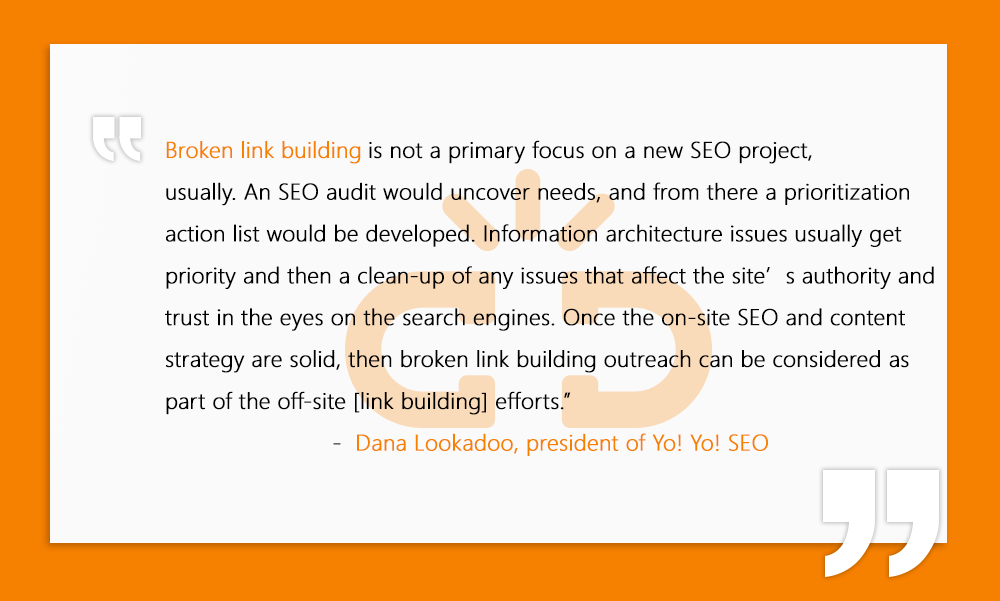
And here’s a quick checklist of what NOT to do while link building:
Do you own a brick-and-mortar business that’s related to your e-commerce site? You can greatly benefit by adding your local SEO elements for better organic results.
Make sure you implement the following:
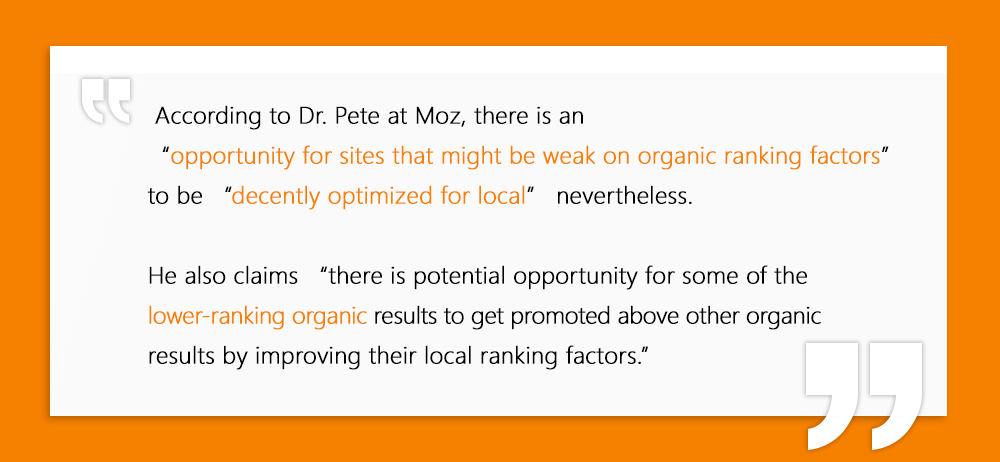
An effective SEO campaign is all about constant monitoring of of your sites performance. It requires time and resources for a successful implementation.
Whether you are trying to get your site to rank better or you are maintaining your high ranking, you need a host of performance metrics to know where you stand and also to get an idea about what your competitors are up to.
Luckily, there’s no dearth of such tools on the internet. But the challenge is to find the best among them.
Here, we present you with a list of some of the most powerful SEO tools that you can use for a wide range of requirements.
Based on your needs, you might find most/all of these useful.
These tools are designed by industry experts to provide you with the invaluable data and insights that you require so your site performs to its true potential.
Website owners all over the world turn to SEO for many reasons. For an e-commerce site such as yours, the primary reason should be to increase sales.
While it’s important to note that SEO is an on-going process and that you need to give it some time before you can see the results, you should always remember that when done right, these techniques are bound to produce results.
From tracking your competitors’ performance to keeping yourself abreast of search engine updates, this process requires tremendous amount of effort and commitment.
But it’s all well worth in the end.
And remember, just like other successes in life, there’s no short cut to a successful SEO campaign.

LEAVE A REPLY